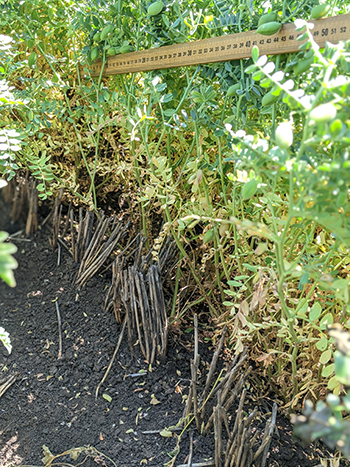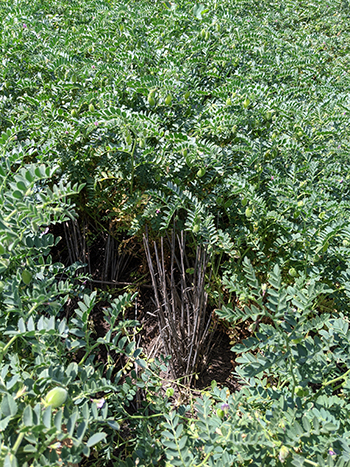Growers using stripper fronts need to consider the risk of crop losses to Fusarium crown rot caused by the fungus Fusarium pseudograminearum.
Experts say crown rot can cause significant yield reductions when temperatures rise and crops start to fill grain.
Random surveys through New South Wales and southern Queensland, as part of the Grains Agronomy and Pathology Partnership between GRDC and the NSW Department of Primary Industries (DPI), identified significant levels of Fusarium crown rot.
The surveys showed 54 per cent of paddocks in north-western NSW had high levels of Fusarium crown rot infection, with an additional 31 per cent recording moderate levels.
Similarly, 45 per cent of paddocks surveyed in southern Queensland showed high levels of infections and 33 per cent recorded moderate levels.
A Delta Agribusiness consulting agronomist and director of Crown Analytical Services, Rob Long, says while the start to 2022 was wet, it is trending to be a drier finish as La Nina dissipates, making it the perfect storm for crown rot expression.
Toni Petronaitis, a cereal pathology research officer at NSW DPI, says stubble retention promotes the carryover of Fusarium pseudograminearum to subsequent cereal crops.

Stem browning caused by crown rot in an experimental plot of bread wheat in 2021, following a tall stubble treatment (2019) and chickpea break crop (2020). Photo: Toni Petronaitis
“The adoption of higher harvest heights through the use of stripper fronts, light tillage with Kelly chains and rotations with shorter-stature break crops such as chickpeas are common in the northern growing region,” Ms Petronaitis says.
“Stripper front harvesting systems improve harvest efficiency through the rapid ‘stripping’ of heads during harvest.
“But stripper fronts leave standing stubble at around 50 to 60 centimetres in height compared with a draper front at 30cm.”
Ms Petronaitis says the fungal pathogen can survive in post-harvest cereal stubble for about three years and can also grow after harvest by a process known as saprotrophic colonisation.
“Additional cereal stubble remaining from stripper front harvests may increase the opportunity for saprotrophic colonisation because there is more cereal stubble available for the fungus to colonise, compared to what remains from conventional or shorter harvest heights,” she says.
“There is more potential to increase inoculum levels and dispersal. Lowering the harvest height of a cereal crop infected with Fusarium pseudograminearum may restrict saprotrophic colonisation of standing cereal stubble after harvest.
“If true, reducing or modifying the harvest height of cereals infected with Fusarium crown rot could be beneficial for preventing further increases in Fusarium pseudograminearum inoculum levels during fallow or non-host periods.”
Experiments in NSW
Researchers with GRDC and NSW DPI investment set up experiments at Breeza and Narrabri in northern NSW from 2019 to 2021.
Cereal stubble (DBA Lillaroi (PBR) durum wheat) infected with Fusarium pseudograminearum was established at both sites during 2019.
The researchers imposed a range of harvest heights (low, medium or high) and harvest trash returned to the plot or trash removed at harvest.
PBA Seamer was sown across both experiments in 2020.
Durum stubble from 30 plants was collected at random across each plot in November 2019 (durum harvest), May 2020 (chickpea sowing) and November 2020 (chickpea harvest).
The pathogen incidence was recorded from plant stems to assess the pathogen progression vertically within the stem every six months.
Study results
Shortly before the chickpeas were sown, Ms Petronaitis says the pathogen was able to grow to the cut height of the stubble.
“The pathogen’s growth was uncapped, and it was able to use the entire stubble resource available,” she says. “Just before the chickpeas were harvested, the growth of the pathogen was maintained and was spread when the chickpeas were harvested. But lowering the harvest height stopped pathogen progression at the lower stubble height.”
Different stubbles
Ms Petronaitis has assessed pathogen growth during the saprotrophic stage by inoculating sterile samples of a range of cereal stubbles with different crown rot resistance ratings.
“We found that different varieties of the same crop species did not have any effect on pathogen colonisation,” she says. “In terms of different cereal crop species, we did see some differences, but it did not relate to the susceptibility of the crop to crown rot.”
 Shorter cereal stubble containing the crown rot pathogen was below the lowest pod height in a subsequent chickpea crop, remaining undisturbed at chickpea harvest. Photo: Toni Petronaitis
Shorter cereal stubble containing the crown rot pathogen was below the lowest pod height in a subsequent chickpea crop, remaining undisturbed at chickpea harvest. Photo: Toni Petronaitis
For example, she says the pathogen grew the furthest in oats, but oats do not have any disease ratings for crown rot because it is not considered to be a significant problem for the crop.
However, oats that are infected, she says, have shown the pathogen can grow in the stubble after harvest as quickly as a susceptible or very susceptible durum wheat stubble. This is an important finding and has implications for planning crop rotations.
Stripper front implications
Ms Petronaitis says the study confirms the crown rot pathogen can colonise the full length of cereal stubble, given sufficient fallow rain.
“Harvesting higher with a stripper front may therefore increase the risk of higher pathogen inoculum levels compared to harvesting at a lower height with a conventional header,” she says. “Widespread use of stripper fronts could result in further increases in crown rot incidence and severity.”
She suggests planning for stubble management, including the stubble and harvest height before harvest, based on the infection status of the cereal crop to be harvested. This would also assist in planning the next crop.
In cereal crops infected with Fusarium pseudograminearum, she says, reducing the stubble height by harvesting lower would be a useful strategy to limit saprotrophic colonisation after harvest and could reduce the probability of subsequent cereal crop infection levels.
“Ideally, the harvest height should be just above the height colonised by Fusarium pseudograminearum to reduce the spread of infected stubble into the inter-row. This way inter-row sowing can be used to reduce the probability of infection in subsequent cereal crops. This approach could be used with stripper fronts, by using the stripper front to collect the grain, if desired, then reducing the height of the stubble. “This allows the cut fraction, free of the pathogen, to be distributed as mulch or baled and removed.
“If saprotrophic colonisation has occurred during a wet summer, cutting low, bailing and removing the infected stubble before sowing the next crop is preferred to burning the stubble.”
The main reason for this approach is to reduce run-off from summer rainfall and maximise summer fallow efficiency. This way there is still a proportion of ground cover to protect the soil surface, but the bulk of inoculum that may infect the following crop has been removed, she says.
 Taller stubble was well within the chickpea canopy in a subsequent chickpea crop, and the upper portion of the stubble containing the crown rot pathogen was dispersed at chickpea harvest. Matching stubble height to the expected harvest height of the next crop in rotation might be an effective strategy for preventing crown rot inoculum dispersal. Photo: Toni Petronaitis
Taller stubble was well within the chickpea canopy in a subsequent chickpea crop, and the upper portion of the stubble containing the crown rot pathogen was dispersed at chickpea harvest. Matching stubble height to the expected harvest height of the next crop in rotation might be an effective strategy for preventing crown rot inoculum dispersal. Photo: Toni Petronaitis
“Restricting the movement of Fusarium pseudograminearum vertically within standing stubble may provide three benefits.
“First, it prevents further inoculum build-up within the standing stubble, above that present at harvest.
“Second, it can stop inoculum spread across a paddock during the harvest of short-stature crops such as chickpea where last year’s cereal stubble is still present.
“Third, it maximises the likely benefits from inter-sowing sowing which reduces the probability of infection where a second cereal crop is planted.”
While stripper fronts offer more-efficient crop harvesting, she says they could potentially create future issues in cereal crops infected with Fusarium crown rot.
“Even if only low levels of infection are experienced during the growing season or disease expressions such as stem browning or whiteheads are restricted by favourable seasonal conditions or plant tolerance, rapid colonisation of stubble may still occur after plant senescence.
“Check your cereal crops for disease symptoms and consider confirmation of inoculum levels using PREDICTA® B.”
Ms Petronaitis also suggests sending stubble samples for diagnostic testing to determine the crown rot infection status of the crop before deciding to cut stripper front stubble at a lower height. For more information, phone Dr Steve Simpfendorfer on
More information: Toni Petronaitis, toni.petronaitis@dpi.nsw.gov.au

























































